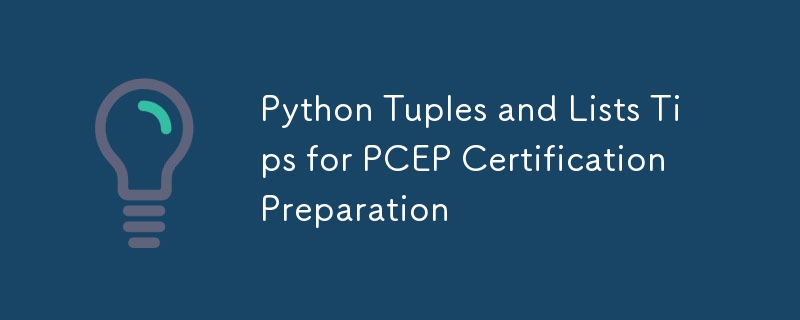Python のタプルとリスト PCEP 認定準備のヒント

Python 認定エントリーレベル プログラマー (PCEP) を目指すには、リストやタプルなど、Python の基本的なデータ構造を完全に理解する必要があります。
リストとタプルはどちらも Python でオブジェクトを保存できますが、これら 2 つのデータ構造には使用法と構文に大きな違いがあります。 PCEP 認定試験に合格するために、これらのデータ構造を習得するための重要なヒントをいくつか紹介します。
1.リストとタプルの違いを理解する
Python のリストは変更可能です。つまり、作成後に変更できます。一方、タプルは不変です。つまり、一度作成すると変更することはできません。これは、タプルのメモリ要件が低く、特定の状況ではリストより高速になる可能性がありますが、柔軟性が低いことを意味します。
リストの例:
# creating a list of numbers numbers = [1, 2, 3, 4, 5] # modifying the list by changing the fourth element numbers[3] = 10 print(numbers) # output: [1, 2, 3, 10, 5]
タプルの例:
# creating a tuple of colors
colors = ("red", "green", "blue")
# trying to modify the tuple by changing the second element
colors[1] = "yellow"
# this will result in an error as tuples are immutable
2.リストとタプルの構文を理解する
リストは角括弧 [ ] で示され、タプルは括弧 ( ) で囲まれます。リストまたはタプルの作成は、適切な構文を使用して変数に値を宣言するのと同じくらい簡単です。タプルは初期化後に変更できないため、正しい構文を使用することが重要であることに注意してください。
リストの例:
# creating a list of fruits fruits = ["apple", "banana", "orange"]
タプルの例:
# creating a tuple of colors
colors = ("red", "green", "blue")
3.アイテムの追加と削除の方法を知る
リストには、append()、extend()、remove() など、項目を追加および削除するためのさまざまな組み込みメソッドがあります。一方、タプルには組み込みメソッドが少なく、項目を追加または削除するメソッドがありません。したがって、タプルを変更する必要がある場合は、既存のタプルを変更するのではなく、新しいタプルを作成する必要があります。
リストの例:
# adding a new fruit to the end of the list
fruits.append("mango")
print(fruits)
# output: ["apple", "banana", "orange", "mango"]
# removing a fruit from the list
fruits.remove("banana")
print(fruits)
# output: ["apple", "orange", "mango"]
タプルの例:
# trying to add a fruit to the end of the tuple
fruits.append("mango")
# this will result in an error as tuples are immutable
# trying to remove a fruit from the tuple
fruits.remove("banana")
# this will also result in an error
4.パフォーマンスの違いを理解する
タプルは不変であるため、一般にリストよりも高速です。項目の固定コレクションを保存する必要があるシナリオに注意し、パフォーマンスを向上させるためにリストの代わりにタプルを使用することを検討してください。
Python の timeit モジュールを使用して、リストとタプルのパフォーマンスの違いをテストできます。以下は、リストと 10 個の要素を持つタプルの反復処理にかかる時間を比較する例です:
# importing the timeit module
import timeit
# creating a list and a tuple with 10 elements
numbers_list = [1, 2, 3, 4, 5, 6, 7, 8, 9, 10]
numbers_tuple = (1, 2, 3, 4, 5, 6, 7, 8, 9, 10)
# testing the time it takes to iterate through the list
list_time = timeit.timeit('for num in numbers_list: pass', globals=globals(), number=100000)
print("Time taken for list: ", list_time)
# output: Time taken for list: 0.01176179499915356 seconds
# testing the time it takes to iterate through the tuple
tuple_time = timeit.timeit('for num in numbers_tuple: pass', globals=globals(), number=100000)
print("Time taken for tuple: ", tuple_time)
# output: Time taken for tuple: 0.006707087000323646 seconds
ご覧のとおり、タプルの反復処理はリストの反復処理よりもわずかに高速です。
5.リストとタプルの適切な使用例を理解する
リストは簡単に変更できるため、時間の経過とともに変化する可能性のある項目のコレクションを保存するのに適しています。対照的に、タプルは、変更しない必要がある項目の定数コレクションに最適です。たとえば、リストは変更される可能性のある食料品リストには適していますが、曜日が変わらないため、曜日を保存するにはタプルの方が適しています。
リストの例:
# creating a list of groceries
grocery_list = ["milk", "bread", "eggs", "chicken"]
# adding a new item to the grocery list
grocery_list.append("bananas")
タプルの例:
# creating a tuple of weekdays
weekdays = ("Monday", "Tuesday", "Wednesday", "Thursday", "Friday")
# trying to add a new day to the tuple
weekdays.append("Saturday")
# this will result in an error as tuples cannot be modified after creation
6.メモリ使用量に注意する
リストはその柔軟性によりタプルよりも多くのメモリを消費しますが、タプルは不変であるため占有するスペースが少なくなります。これは、大規模なデータセットやメモリを大量に使用するアプリケーションを扱う場合に考慮することが特に重要です。
Python の sys モジュールを使用して変数のメモリ使用量を確認できます。以下は、リストと 100 万個の要素を持つタプルのメモリ使用量を比較する例です:
# importing the sys module
import sys
# creating a list with one million elements
numbers_list = list(range(1000000))
# checking the memory usage of the list
list_memory = sys.getsizeof(numbers_list)
print("Memory usage for list: ", list_memory)
# output: Memory usage for list: 9000112 bytes
# creating a tuple with one million elements
numbers_tuple = tuple(range(1000000))
# checking the memory usage of the tuple
tuple_memory = sys.getsizeof(numbers_tuple)
print("Memory usage for tuple: ", tuple_memory)
# output: Memory usage for tuple: 4000072 bytes
リストに比べてタプルはメモリ消費量が少ないことがわかります。
7.リストとタプルを反復処理する方法を知る
リストとタプルはどちらもループを使用して反復できますが、不変であるため、タプルの方がわずかに高速である可能性があります。また、リストには任意のタイプのデータを格納できますが、タプルにはハッシュ可能な要素のみを含めることができることに注意してください。これは、タプルは辞書キーとして使用できるが、リストは使用できないことを意味します。
リストの例:
# creating a list of numbers
numbers = [1, 2, 3, 4, 5]
# iterating through the list and checking if a number is present
for num in numbers:
if num == 3:
print("Number 3 is present in the list")
# output: Number 3 is present in the list
タプルの例:
# creating a tuple of colors
colors = ("red", "green", "blue")
# iterating through the tuple and checking if a color is present
for color in colors:
if color == "yellow":
print("Yellow is one of the colors in the tuple")
# this will not print anything as yellow is not present in the tuple
8.組み込み関数と操作に慣れる
リストにはタプルに比べて多くの組み込みメソッドがありますが、両方のデータ構造には、PCEP 試験に慣れておく必要があるさまざまな組み込み関数と演算子があります。これらには、len()、max()、min() などの関数のほか、項目がリストまたはタプル内にあるかどうかをチェックする in や not in などの演算子が含まれます。
リストの例:
# creating a list of even numbers
numbers = [2, 4, 6, 8, 10]
# using the len() function to get the length of the list
print("Length of the list: ", len(numbers))
# output: Length of the list: 5
# using the in and not in operators to check if a number is present in the list
print(12 in numbers)
# output: False
print(5 not in numbers)
# output: True
タプルの例:
# creating a tuple of colors
colors = ("red", "green", "blue")
# using the max() function to get the maximum element in the tuple
print("Maximum color: ", max(colors))
# output: Maximum color: red
# using the in and not in operators to check if a color is present in the tuple
print("yellow" in colors)
# output: False
print("green" not in colors)
# output: False
リストとタプルの違い、適切な使用例、構文を理解することで、PCEP 試験の準備が整います。知識を確実にし、試験に合格する可能性を高めるために、さまざまなシナリオでこれらのデータ構造を使用する練習を忘れないでください。練習すれば完璧になるということを覚えておいてください!
-
 数字のみの出力で単一の数字認識のためにPytesseractを構成するにはどうすればよいですか?pytesseract ocrを備えたpytesseract ocr pytesseractのコンテキストで、単一桁を認識し、数字を抑制するためにテッセラクトを構成します。この問題に対処するために、Tesseractの構成オプションの詳細を掘り下げます。単一文字認識の場合、適切な...プログラミング 2025-04-12に投稿されました
数字のみの出力で単一の数字認識のためにPytesseractを構成するにはどうすればよいですか?pytesseract ocrを備えたpytesseract ocr pytesseractのコンテキストで、単一桁を認識し、数字を抑制するためにテッセラクトを構成します。この問題に対処するために、Tesseractの構成オプションの詳細を掘り下げます。単一文字認識の場合、適切な...プログラミング 2025-04-12に投稿されました -
 交換指令を使用して、GO modのモジュールパスの不一致を解決する方法は?go mod のモジュールパスの不一致を克服するgo modを利用する場合、輸入パッケージと実際の輸入パスの間のパスミスマッチとのパスミスマッチで、第三者パッケージが別のパッケージをインポートする紛争に遭遇する可能性があります。エコーされたメッセージで示されているように、これはGo M...プログラミング 2025-04-12に投稿されました
交換指令を使用して、GO modのモジュールパスの不一致を解決する方法は?go mod のモジュールパスの不一致を克服するgo modを利用する場合、輸入パッケージと実際の輸入パスの間のパスミスマッチとのパスミスマッチで、第三者パッケージが別のパッケージをインポートする紛争に遭遇する可能性があります。エコーされたメッセージで示されているように、これはGo M...プログラミング 2025-04-12に投稿されました -
 PHPを使用してBlob(画像)をMySQLに適切に挿入する方法は?php mysqlデータベースを持つmysqlデータベースにブロブを挿入すると、mysqlデータベースに画像を保存しようとすると、遭遇するかもしれません問題。このガイドは、画像データを正常に保存するためのソリューションを提供します。 ImageId、image) values( &...プログラミング 2025-04-12に投稿されました
PHPを使用してBlob(画像)をMySQLに適切に挿入する方法は?php mysqlデータベースを持つmysqlデータベースにブロブを挿入すると、mysqlデータベースに画像を保存しようとすると、遭遇するかもしれません問題。このガイドは、画像データを正常に保存するためのソリューションを提供します。 ImageId、image) values( &...プログラミング 2025-04-12に投稿されました -
 マウスクリック時にDiv内のすべてのテキストをプログラム的に選択するにはどうすればよいですか?マウスクリックでプログラムをプログラム的に選択する 質問 テキストコンテンツのdiv要素が与えられた場合、ユーザーは1つのマウスクリックでdiv内のテキスト全体をプログラム的に選択できますか?これにより、ユーザーは選択したテキストを簡単にドラッグアンドドロップしたり、直接コピーしたりできます。...プログラミング 2025-04-12に投稿されました
マウスクリック時にDiv内のすべてのテキストをプログラム的に選択するにはどうすればよいですか?マウスクリックでプログラムをプログラム的に選択する 質問 テキストコンテンツのdiv要素が与えられた場合、ユーザーは1つのマウスクリックでdiv内のテキスト全体をプログラム的に選択できますか?これにより、ユーザーは選択したテキストを簡単にドラッグアンドドロップしたり、直接コピーしたりできます。...プログラミング 2025-04-12に投稿されました -
 複数のユーザータイプ(学生、教師、および管理者)をFireBaseアプリでそれぞれのアクティビティにリダイレクトする方法は?red:複数のユーザータイプをそれぞれのアクティビティにリダイレクトする方法 ログイン。現在のコードは、2つのユーザータイプのリダイレクトを正常に管理しますが、3番目のタイプ(admin)を組み込もうとするときに課題に直面します。元のスキーマは、2種類のユーザーのみに対応していました。 3...プログラミング 2025-04-12に投稿されました
複数のユーザータイプ(学生、教師、および管理者)をFireBaseアプリでそれぞれのアクティビティにリダイレクトする方法は?red:複数のユーザータイプをそれぞれのアクティビティにリダイレクトする方法 ログイン。現在のコードは、2つのユーザータイプのリダイレクトを正常に管理しますが、3番目のタイプ(admin)を組み込もうとするときに課題に直面します。元のスキーマは、2種類のユーザーのみに対応していました。 3...プログラミング 2025-04-12に投稿されました -
 解決する方法\「スクリプト... \ "Androidのコンテンツセキュリティポリシーによるエラーのロードを拒否しましたか?ミステリーを発表する:コンテンツセキュリティポリシー指示エラー 謎めいたエラーに遭遇する「スクリプトのロードを拒否する...」Androidアプリを展開するときに?この問題は、信頼されていないソースからのリソースの負荷を制限するコンテンツセキュリティポリシー(CSP)指令に由来しています。...プログラミング 2025-04-12に投稿されました
解決する方法\「スクリプト... \ "Androidのコンテンツセキュリティポリシーによるエラーのロードを拒否しましたか?ミステリーを発表する:コンテンツセキュリティポリシー指示エラー 謎めいたエラーに遭遇する「スクリプトのロードを拒否する...」Androidアプリを展開するときに?この問題は、信頼されていないソースからのリソースの負荷を制限するコンテンツセキュリティポリシー(CSP)指令に由来しています。...プログラミング 2025-04-12に投稿されました -
 PHPでタイムゾーンを効率的に変換する方法は?php での効率的なタイムゾーン変換は、タイムゾーンの取り扱いは簡単なタスクになる可能性があります。このガイドは、異なるタイムゾーン間で日付と時間を変換するための簡単な実装方法を提供します。たとえば、 //ユーザーのタイムゾーンを定義します date_default_timezone_s...プログラミング 2025-04-12に投稿されました
PHPでタイムゾーンを効率的に変換する方法は?php での効率的なタイムゾーン変換は、タイムゾーンの取り扱いは簡単なタスクになる可能性があります。このガイドは、異なるタイムゾーン間で日付と時間を変換するための簡単な実装方法を提供します。たとえば、 //ユーザーのタイムゾーンを定義します date_default_timezone_s...プログラミング 2025-04-12に投稿されました -
 JavaScriptオブジェクトにキーを動的に設定する方法は?JavaScriptオブジェクト変数の動的キーを作成する方法 この構文jsObj['key' i] = 'example' 1; はjavascriptで、アレイは特殊なタイプのオブジェクトです。この特別な動作は標準のオブジェクトによって模倣されていませんが、四角いブラケット演算子は...プログラミング 2025-04-12に投稿されました
JavaScriptオブジェクトにキーを動的に設定する方法は?JavaScriptオブジェクト変数の動的キーを作成する方法 この構文jsObj['key' i] = 'example' 1; はjavascriptで、アレイは特殊なタイプのオブジェクトです。この特別な動作は標準のオブジェクトによって模倣されていませんが、四角いブラケット演算子は...プログラミング 2025-04-12に投稿されました -
 オブジェクトフィット:IEとEdgeでカバーが失敗します、修正方法は?object-fit:カバーがIEとEDGEで失敗します。 CSSでは、一貫した画像の高さを維持するために、ブラウザ全体でシームレスに動作します。ただし、IEとEdgeでは、独特の問題が発生します。ブラウザをスケーリングすると、画像は高さをズームするのではなく幅でサイズを変更し、外観を歪め...プログラミング 2025-04-12に投稿されました
オブジェクトフィット:IEとEdgeでカバーが失敗します、修正方法は?object-fit:カバーがIEとEDGEで失敗します。 CSSでは、一貫した画像の高さを維持するために、ブラウザ全体でシームレスに動作します。ただし、IEとEdgeでは、独特の問題が発生します。ブラウザをスケーリングすると、画像は高さをズームするのではなく幅でサイズを変更し、外観を歪め...プログラミング 2025-04-12に投稿されました -
 Pythonのリクエストと偽のユーザーエージェントでWebサイトブロックをバイパスする方法は?Pythonのリクエストと偽のユーザーエージェントでブラウザの動作をシミュレートする方法これは、Webサイトが実際のブラウザと自動化されたスクリプトを区別するアンチボット測定を実装できるためです。これらのブロックをバイパスするために、開発者はブラウザの動作を模倣してカスタムユーザーエージェ...プログラミング 2025-04-12に投稿されました
Pythonのリクエストと偽のユーザーエージェントでWebサイトブロックをバイパスする方法は?Pythonのリクエストと偽のユーザーエージェントでブラウザの動作をシミュレートする方法これは、Webサイトが実際のブラウザと自動化されたスクリプトを区別するアンチボット測定を実装できるためです。これらのブロックをバイパスするために、開発者はブラウザの動作を模倣してカスタムユーザーエージェ...プログラミング 2025-04-12に投稿されました -
 なぜ `body {margin:0; } `常にCSSの上限を削除しますか?css の扱います。多くの場合、「ボディ{マージン:0;}」などの提供されたコードは、目的の結果を生成しません。これは、コンテンツの親要素が正のパディング値を持っている場合に発生する可能性があります。特定のマージンの問題に対処することをお勧めします。親要素にパディングがある場合、それを...プログラミング 2025-04-12に投稿されました
なぜ `body {margin:0; } `常にCSSの上限を削除しますか?css の扱います。多くの場合、「ボディ{マージン:0;}」などの提供されたコードは、目的の結果を生成しません。これは、コンテンツの親要素が正のパディング値を持っている場合に発生する可能性があります。特定のマージンの問題に対処することをお勧めします。親要素にパディングがある場合、それを...プログラミング 2025-04-12に投稿されました -
 なぜPHPのDateTime :: Modify( '+1 Month')が予期しない結果を生み出すのですか?PHP DateTimeで月数の変更:PHPのDateTimeクラスを操作する場合、数か月を追加または減算する場合、意図した動作を発見します。ドキュメントが警告しているように、これらの操作は見た目ほど直感的ではないため、これらの操作に「注意してください」。 $ date-> modify(...プログラミング 2025-04-12に投稿されました
なぜPHPのDateTime :: Modify( '+1 Month')が予期しない結果を生み出すのですか?PHP DateTimeで月数の変更:PHPのDateTimeクラスを操作する場合、数か月を追加または減算する場合、意図した動作を発見します。ドキュメントが警告しているように、これらの操作は見た目ほど直感的ではないため、これらの操作に「注意してください」。 $ date-> modify(...プログラミング 2025-04-12に投稿されました -
 Pythonを使用して、大きなファイルを逆の順序で効率的に読み取るにはどうすればよいですか?Python でファイルを逆順序で読み取る必要があり、最後の行から最初の行までの内容を読み取る必要がある場合、Pythonの組み込み機能は適切ではないかもしれません。このタスクに取り組むための効率的なソリューションは次のとおりです。バッファベースのアプローチを使用してパフォーマンスを最...プログラミング 2025-04-12に投稿されました
Pythonを使用して、大きなファイルを逆の順序で効率的に読み取るにはどうすればよいですか?Python でファイルを逆順序で読み取る必要があり、最後の行から最初の行までの内容を読み取る必要がある場合、Pythonの組み込み機能は適切ではないかもしれません。このタスクに取り組むための効率的なソリューションは次のとおりです。バッファベースのアプローチを使用してパフォーマンスを最...プログラミング 2025-04-12に投稿されました -
 PDOパラメーターを使用してクエリのように正しく使用する方法は?を使用してpdo PDOで同様のクエリを実装しようとすると、以下のクエリのような問題に遭遇する可能性があります: $query = "SELECT * FROM tbl WHERE address LIKE '%?%' OR address LIKE '%?%'";...プログラミング 2025-04-12に投稿されました
PDOパラメーターを使用してクエリのように正しく使用する方法は?を使用してpdo PDOで同様のクエリを実装しようとすると、以下のクエリのような問題に遭遇する可能性があります: $query = "SELECT * FROM tbl WHERE address LIKE '%?%' OR address LIKE '%?%'";...プログラミング 2025-04-12に投稿されました -
 GOコンパイラでコンパイルの最適化をカスタマイズするにはどうすればよいですか?goコンパイラ のコンピレーション最適化のカスタマイズGOのデフォルトのコンパイルプロセスは、特定の最適化戦略に従います。ただし、ユーザーは特定の要件に対してこれらの最適化を調整する必要がある場合があります。これは、コンパイラが事前に定義されたヒューリスティックに基づいて最適化を自動的に...プログラミング 2025-04-12に投稿されました
GOコンパイラでコンパイルの最適化をカスタマイズするにはどうすればよいですか?goコンパイラ のコンピレーション最適化のカスタマイズGOのデフォルトのコンパイルプロセスは、特定の最適化戦略に従います。ただし、ユーザーは特定の要件に対してこれらの最適化を調整する必要がある場合があります。これは、コンパイラが事前に定義されたヒューリスティックに基づいて最適化を自動的に...プログラミング 2025-04-12に投稿されました
中国語を勉強する
- 1 「歩く」は中国語で何と言いますか? 走路 中国語の発音、走路 中国語学習
- 2 「飛行機に乗る」は中国語で何と言いますか? 坐飞机 中国語の発音、坐飞机 中国語学習
- 3 「電車に乗る」は中国語で何と言いますか? 坐火车 中国語の発音、坐火车 中国語学習
- 4 「バスに乗る」は中国語で何と言いますか? 坐车 中国語の発音、坐车 中国語学習
- 5 中国語でドライブは何と言うでしょう? 开车 中国語の発音、开车 中国語学習
- 6 水泳は中国語で何と言うでしょう? 游泳 中国語の発音、游泳 中国語学習
- 7 中国語で自転車に乗るってなんて言うの? 骑自行车 中国語の発音、骑自行车 中国語学習
- 8 中国語で挨拶はなんて言うの? 你好中国語の発音、你好中国語学習
- 9 中国語でありがとうってなんて言うの? 谢谢中国語の発音、谢谢中国語学習
- 10 How to say goodbye in Chinese? 再见Chinese pronunciation, 再见Chinese learning

























